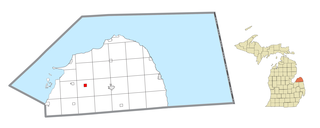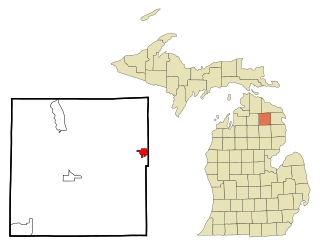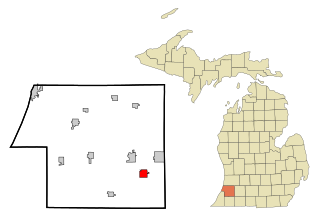
Baraga is a village in Baraga County in the U.S. state of Michigan. The population was 1,883 at the 2020 census. The village is named after Bishop Frederic Baraga.

Athens is a village in Calhoun County in the U.S. state of Michigan. The population was 936 at the 2020 census. The village is located in southern Athens Township, and is part of the Battle Creek, Michigan Metropolitan Statistical Area. It was settled in 1831.

Burlington is a village in Calhoun County in the U.S. state of Michigan. The population was 281 at the 2020 census. It is part of the Battle Creek, Michigan Metropolitan Statistical Area. The village is located within Burlington Township on M-60.

Elkton is a village in Huron County in the U.S. state of Michigan. The population was 796 at the 2020 census. The village is within Oliver Township, along the Pinnebog River. It was incorporated in 1897.

Owendale is a village in Huron County of the U.S. state of Michigan. The population was 241 at the 2010 census. The village is within Brookfield Township.

Pigeon is a village in Huron County in the U.S. state of Michigan. The population was 1,208 at the 2010 census. The village is within Winsor Township.

Webberville is a village in Ingham County in the U.S. state of Michigan. It is located within Leroy Township. The population was 1,288 at the 2020 census.

Clinton is a village in Lenawee County in the Irish Hills area of the U.S. state of Michigan. The population was 2,336 at the 2010 census. The village is located within Clinton Township.

Turin Township is a civil township of Marquette County in the U.S. state of Michigan. As of the 2020 census, the township population was 110, down from 153 in 2010.

Hillman is a village in Alpena and Montmorency counties in the U.S. state of Michigan. The population was 605 as of the 2020 census. Nearly all of the village is located within Hillman Township, with only a small portion extending into Green Township.

Merrill is a village in Saginaw County in the U.S. state of Michigan. The population was 663 at the 2020 census. The village is located within Jonesfield Township.

Forestville is a village in Sanilac County in the U.S. state of Michigan. The population was 104 at the 2020 census, making it the least-populous village in Michigan. It does not have a true harbor onto Lake Huron, but the village does have a boat launch site. Forestville receives city water from nearby Harbor Beach. The village is within Delaware Township.
Elmwood Township is a civil township of Tuscola County in the U.S. state of Michigan. The population was 1,060 at the 2020 census.
Tuscola Township is a civil township of Tuscola County in the U.S. state of Michigan. The population was 1,978 at the 2020 census.

Lawrence is a village in Van Buren County in the U.S. state of Michigan. The population was 996 at the 2010 census. The village is located within Lawrence Township. It is host to an annual Ox Roast, Homecoming festival, and Farmer's Market.

Lawton is a village in southeastern Van Buren County, Michigan, United States. The population was 1,900 at the 2010 census.

Mesick is a village in Wexford County in the U.S. state of Michigan. The population was 397 at the 2020 census. The majority of the village is located within Springville Township with a very small portion extending east into Antioch Township.

South Pottstown is a community in North Coventry Township, Chester County in the U.S. state of Pennsylvania. It is defined by the U.S. Census Bureau as a census-designated place (CDP) for statistical purposes and does not have any legal status as a separately incorporated municipality. It is a part of the Pottstown urban area. The population was 2,081 at the 2010 census.

Oliver is a village in Douglas County, Wisconsin, United States. The population was 423 at the 2020 census.
Lennon is a village in the U.S. state of Michigan. The population was 511 at the 2010 census. The village is located along M-13 within Venice Township in Shiawassee County to the west and Clayton Township in Genesee County to the east.


















